
The MCS-48 microcontroller series, Intel's first microcontroller, was originally released in 1976. Its first members were 8048, 8035 and 8748. The 8048 is arguably the most prominent member of the family. Initially, this family was produced using NMOS technology. In the early 1980s, it became available in CMOS technology. It was manufactured into the 1990s to support older designs that still used it.
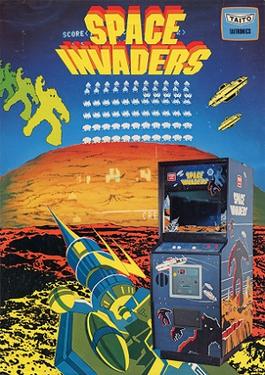
Space Invaders is a 1978 shoot 'em up arcade video game developed and published by Taito. It was released in Japan in April 1978, with the game being released by Midway Manufacturing overseas. Commonly considered to be one of the most influential video games of all time, Space Invaders was the first fixed shooter and the first video game with endless gameplay and set the template for the genre. The goal is to defeat wave after wave of descending aliens with a horizontally moving laser cannon to earn as many points as possible.

Centipede is a 1981 fixed shooter arcade video game developed and published by Atari, Inc. Designed by Dona Bailey and Ed Logg, it was one of the most commercially successful games from the golden age of arcade video games and one of the first with a significant female player base. The primary objective is to shoot all the segments of a centipede that winds down the playing field. An arcade sequel, Millipede, followed in 1982.
A sports video game is a video game that simulates the practice of sports. Most sports have been recreated with video games, including team sports, track and field, extreme sports, and combat sports. Some games emphasize playing the sport, whilst others emphasize strategy and sport management. Some, such as Need for Speed, Arch Rivals and Punch-Out!!, satirize the sport for comic effect. This genre has been popular throughout the history of video games and is competitive, just like real-world sports. A number of game series feature the names and characteristics of real teams and players, and are updated annually to reflect real-world changes. The sports genre is one of the oldest genres in gaming history.
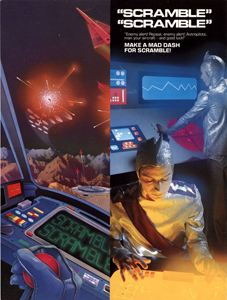
Scramble is a horizontally scrolling shooter arcade video game released in 1981. It was developed by Konami and manufactured and distributed by Leijac in Japan and Stern in North America. It was the first side-scrolling shooter with forced scrolling and multiple distinct levels, and it established the foundation for a new genre.

Contra is a 1987 run and gun video game developed and published by Konami for arcades. A home version was released for the Nintendo Entertainment System in 1988, along with ports for various home computer formats, including the MSX2. The arcade and computer versions were localized as Gryzor in Europe, and the NES version as Probotector in PAL regions and France.
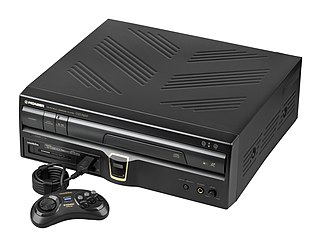
The LaserActive is a converged device and fourth-generation home video game console capable of playing LaserDiscs, Compact Discs, console games, and LD-G karaoke discs. It was released by Pioneer Corporation in 1993. In addition to LaserActive games, separately sold add-on modules accept Mega Drive/Genesis and PC Engine/TurboGrafx-16 ROM cartridges and CD-ROMs.

Simon is an electronic game of short-term memory skill invented by Ralph H. Baer and Howard J. Morrison, working for toy design firm Marvin Glass and Associates, with software programming by Lenny Cope. The device creates a series of tones and lights and requires a user to repeat the sequence. If the user succeeds, the series becomes progressively longer and more complex. Once the user fails or the time limit runs out, the game is over. The original version was manufactured and distributed by Milton Bradley and later by Hasbro after it took over Milton Bradley. Much of the assembly language code was written by Charles Kapps, who taught computer science at Temple University and also wrote one of the first books on the theory of computer programming. Simon was launched in 1978 at Studio 54 in New York City and was an immediate success, becoming a pop culture symbol of the 1970s and 1980s.

Tempest is a 1981 arcade video game by Atari, Inc., designed and programmed by Dave Theurer. It takes place on a three-dimensional surface divided into lanes, sometimes as a closed tube, and viewed from one end. The player controls a claw-shaped "blaster" that sits on the edge of the surface, snapping from segment to segment as a rotary knob is turned, and can fire blaster shots to destroy enemies and obstacles by pressing a button.

Robotron: 2084 is a multidirectional shooter developed by Eugene Jarvis and Larry DeMar of Vid Kidz and released in arcades by Williams Electronics in 1982. The game is set in the year 2084 in a fictional world where robots have turned against humans in a cybernetic revolt. The aim is to defeat endless waves of robots, rescue surviving humans, and earn as many points as possible.

Choplifter is a military themed scrolling shooter developed by Dan Gorlin for the Apple II and published by Broderbund in 1982. It was ported to Atari 8-bit computers the same year and also to the VIC-20, Commodore 64, Atari 5200, ColecoVision, MSX, and Thomson computers.

Star Trek is a text-based strategy video game based on the Star Trek television series (1966–69) and originally released in 1971. In the game, the player commands the USS Enterprise on a mission to hunt down and destroy an invading fleet of Klingon warships. The player travels through the 64 quadrants of the galaxy to attack enemy ships with phasers and photon torpedoes in turn-based battles and refuel at starbases. The goal is to eliminate all enemies within a random time limit.

Star Wars is a first-person rail shooter designed by Mike Hally and released as an arcade video game in 1983 by Atari, Inc. It uses 3D color vector graphics to simulate the assault on the Death Star from the 1977 film Star Wars. There are three connected gameplay sequences: combat against TIE fighters in space, flying across the surface of the Death Star, and the final trench run. The sequence repeats with added complications and the Death Star regenerating for each. The player's X-Wing fighter has a shield which only protects against damage a certain number of times, then the next hit ends the game. Speech synthesis emulates actors from the film.

Tron is a coin-operated arcade video game manufactured and distributed by Bally Midway in 1982. The game consists of four subgames inspired by the events of the Walt Disney Productions motion picture Tron released earlier in the summer. The lead programmer was Bill Adams. The music programmer was Earl Vickers.

Computer Bismarck is a computer wargame developed and published by Strategic Simulations (SSI) in 1980. The game is based on the last battle of the battleship Bismarck, in which British Armed Forces pursue the German Bismarck in 1941. It is SSI's first game, and features turn-based gameplay and two-dimensional graphics.
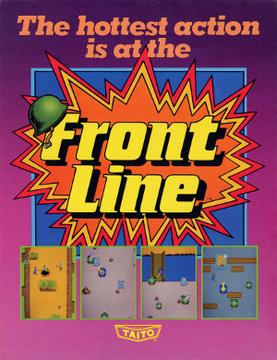
Front Line is a military-themed run and gun video game released by Taito for arcades in November 1982. It was one of the first overhead run and gun games, a precursor to many similarly-themed games of the mid-to-late 1980s. Front Line is controlled with a joystick, a single button, and a rotary dial that can be pushed in like a button. The single button is used to throw grenades and to enter and exit tanks, while the rotary dial aims and fires the player's gun.
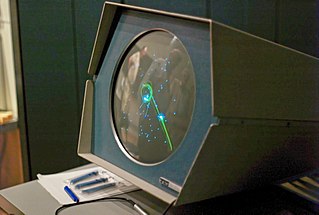
Spacewar! is a space combat video game developed in 1962 by Steve Russell in collaboration with Martin Graetz, Wayne Wiitanen, Bob Saunders, Steve Piner, and others. It was written for the newly installed DEC PDP-1 minicomputer at the Massachusetts Institute of Technology. After its initial creation, Spacewar! was expanded further by other students and employees of universities in the area, including Dan Edwards and Peter Samson. It was also spread to many of the few dozen installations of the PDP-1 computer, making Spacewar! the first known video game to be played at multiple computer installations.
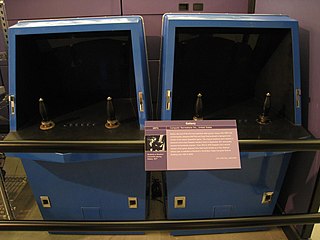
Galaxy Game is a space combat arcade game developed in 1971 during the early era of video games. Galaxy Game is an expanded version of the 1962 Spacewar!, potentially the first video game to spread to multiple computer installations. It features two spaceships, "the needle" and "the wedge", engaged in a dogfight while maneuvering in the gravity well of a star. Both ships are controlled by human players.

Tutankham is a 1982 arcade video game developed and released by Konami and released by Stern in North America. Named after the Egyptian pharaoh Tutankhamun, the game combines a maze shoot 'em up with light puzzle-solving elements. It debuted at the European ATE and IMA amusement shows in January 1982 before releasing worldwide in Summer 1982. The game was a critical and commercial success and was ported to home systems by Parker Brothers.
The history of video games spans a period of time between the invention of the first electronic games and today, covering many inventions and developments. Video gaming reached mainstream popularity in the 1970s and 1980s, when arcade video games, gaming consoles and home computer games were introduced to the general public. Since then, video gaming has become a popular form of entertainment and a part of modern culture in most parts of the world. The early history of video games, therefore, covers the period of time between the first interactive electronic game with an electronic display in 1947, the first true video games in the early 1950s, and the rise of early arcade video games in the 1970s. During this time there was a wide range of devices and inventions corresponding with large advances in computing technology, and the actual first video game is dependent on the definition of "video game" used.


















